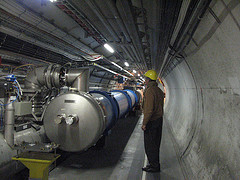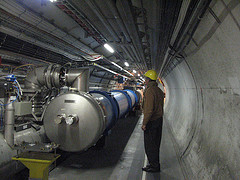
Large Hadron Collider, the world’s largest and most powerful particle collider, has detected particle decays that had been predicted but had never been analyzed before.
The collider, which is part of CERN’s experimental lab near Geneva, has started smashing protons at high speeds since the completion of its two-year renovation. The detected decay pattern observed “could help researchers test the limits of the standard model of particle physics and probe unexplained cosmic phenomena, including the existence of dark matter and the dearth of antimatter in the universe.”
While the standard model of particle physics aligns well with previously detected particles like the Higgs boson, it does not adequately explain the nature and behavior of dark matter which is not directly detectable. The dark matter is considered as the reason behind much of the mass and gravitational influence in the universe. It is also considered as the factor behind the universe’s increasing rate of expansion.
The particles involved in the groundbreaking decay observations are known as neutral B mesons, which decay quickly into other particles. The research team looked at data collected by the LHC concerning the decay rates of two types of B meson, one of which performed at a rate similar to what the standard model predicts, and one of which decayed at a rate almost four times higher than predicted.
While the discrepancy could possibly be attributed to the small sample size of data, it still is a lucrative experiment for scientists to ponder about.
The team plans to collect more data and observe to get a better understanding of the delay.
The collider is now allowing particle beams to travel in both directions inside parallel pipes at a speed just a notch below that of light. Particles are colliding at nearly double the energy the LHC reached during its first run. Built by the European Organization for Nuclear Research (CERN) from 1998 to 2008, the collider is now looking to go beyond the Standard Model.
LHC aims to find sibling particles for its initial detected Higgs particle. The scientists at CERN had used the machine to discover the Higgs boson, commonly called as the God’s particle, in 2012.
The organization at the helm of LHC is supervised by 21 member states and the experiments are conducted by citizens from many other countries. About 3,000 students are involved in the present operations. While CERN is based near Geneva, Switzerland, the ring itself extends underneath the border with France.
The collider, which is part of CERN’s experimental lab near Geneva, has started smashing protons at high speeds since the completion of its two-year renovation. The detected decay pattern observed “could help researchers test the limits of the standard model of particle physics and probe unexplained cosmic phenomena, including the existence of dark matter and the dearth of antimatter in the universe.”
While the standard model of particle physics aligns well with previously detected particles like the Higgs boson, it does not adequately explain the nature and behavior of dark matter which is not directly detectable. The dark matter is considered as the reason behind much of the mass and gravitational influence in the universe. It is also considered as the factor behind the universe’s increasing rate of expansion.
The particles involved in the groundbreaking decay observations are known as neutral B mesons, which decay quickly into other particles. The research team looked at data collected by the LHC concerning the decay rates of two types of B meson, one of which performed at a rate similar to what the standard model predicts, and one of which decayed at a rate almost four times higher than predicted.
While the discrepancy could possibly be attributed to the small sample size of data, it still is a lucrative experiment for scientists to ponder about.
The team plans to collect more data and observe to get a better understanding of the delay.
The collider is now allowing particle beams to travel in both directions inside parallel pipes at a speed just a notch below that of light. Particles are colliding at nearly double the energy the LHC reached during its first run. Built by the European Organization for Nuclear Research (CERN) from 1998 to 2008, the collider is now looking to go beyond the Standard Model.
LHC aims to find sibling particles for its initial detected Higgs particle. The scientists at CERN had used the machine to discover the Higgs boson, commonly called as the God’s particle, in 2012.
The organization at the helm of LHC is supervised by 21 member states and the experiments are conducted by citizens from many other countries. About 3,000 students are involved in the present operations. While CERN is based near Geneva, Switzerland, the ring itself extends underneath the border with France.





